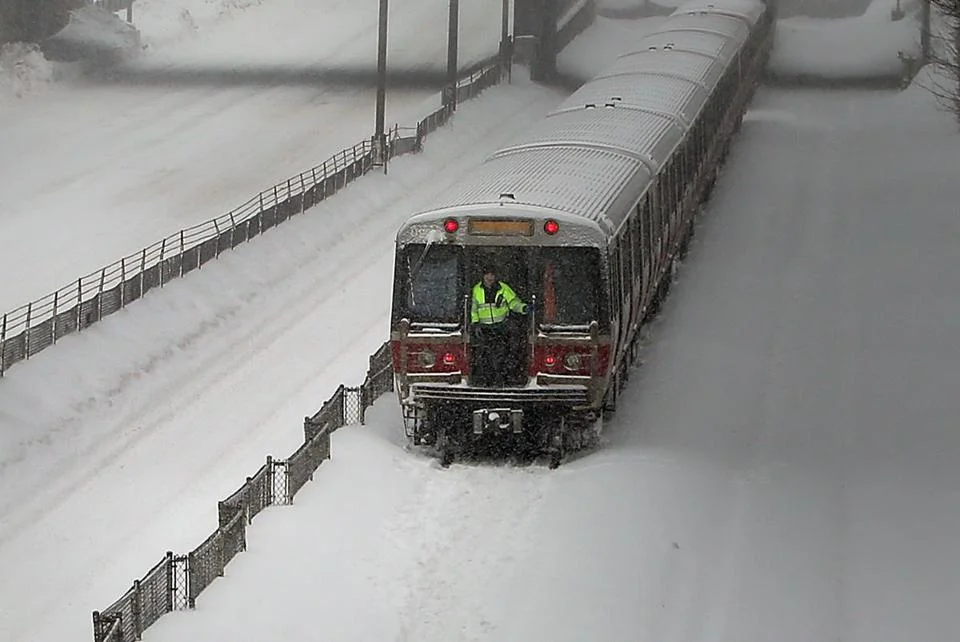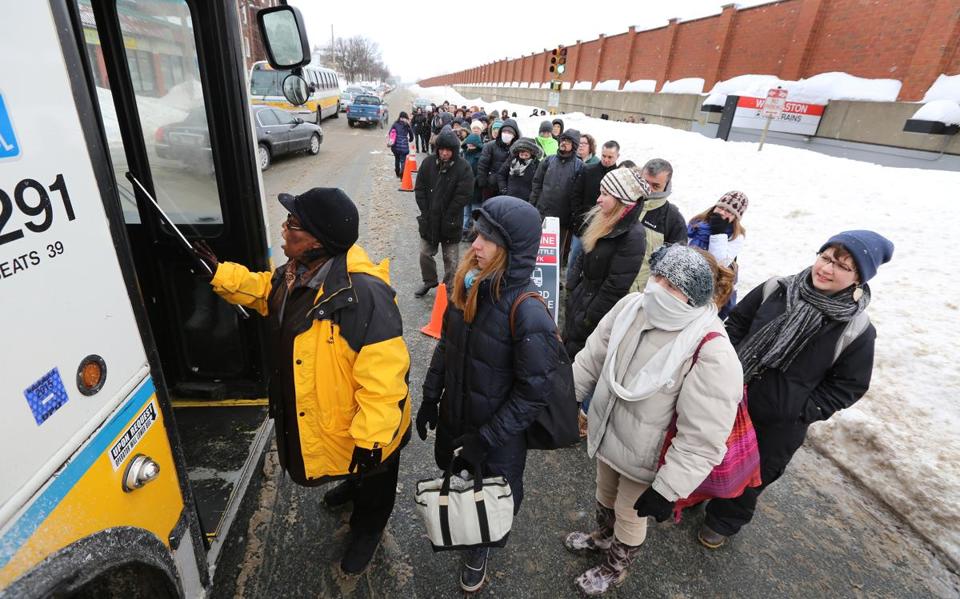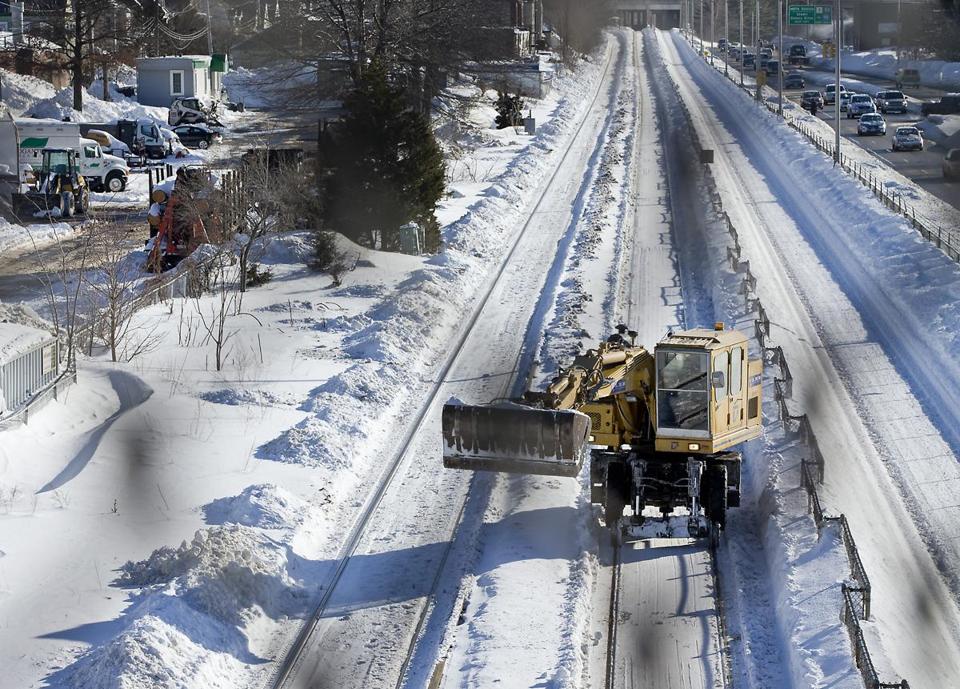
An Emergency Transportation Plan to Fix Boston's Transit Crisis
Yesterday we learned that due to decades of neglect the MBTA will need at least 30 days to restore service to the normal level of delays, signal problems and disabled trains we're used to. While there is plenty of blame to go around, right now we must focus on the current emergency.
Yesterday we learned that due to decades of neglect the MBTA will need at least 30 days to restore service to the normal level of delays, signal problems and disabled trains we're used to. While there is plenty of blame to go around, right now we must focus on the current emergency.




We must act quickly to implement a temporary transit network that would people to resume their lives before the state's economy collapses and half the city's population is out of work. Mayor Walsh and MBTA General Manager Beverly Scott should seek help from cities and transit agencies who have experience with natural disasters. With bold political leadership and around 1,000 buses from across the northeast we can put an emergency transportation plan into action.
For guidance we should look to MTA New York City Transit, which in 2012 implemented emergency "bus bridges" connecting Brooklyn and Manhattan two days after Hurricane Sandy knocked out all subway service in the city's core (photos). The city used simple cones to create dedicated bus lanes along the shuttle route and police officers to enforce the lanes and keep over 200 buses moving on each route. MTA also ran a long-term shuttle route to replace the A line in Queens and a year earlier replaced suspended commuter rail service after Hurricane Irene.
Here and now, a network of emergency shuttle bus routes must be created based roughly on known travel patterns. Bus routes would not exactly mimic subway corridors but they would get you into the city's core where you can walk or use what's left of the T. Some routes would use dedicated bus lanes and receive priority over all other traffic, with police enforcement, while other corridors would be open only to buses. For all of the issues with bus service, the MBTA does a great job running shuttle bus links such as Harvard-Alewife and Lechmere-North Station when things are planned in advance.
Cars carrying fewer than 3 occupants would be prohibited from entering the city or using major highways inside Route 128. Slug lanes would allow those who must drive from suburban areas to pickup additional passengers before continuing on. Large parking lots along I-495 and Route 128 can be turned into park-and-ride lots with bus shuttles operating in dedicated bus lanes on all major highways.
Bikes must be part of the solution. It is certainly cold outside but desperate times call for desperate measures. Better to ride 3 miles in the cold than wait for a bus in the cold for the same 15 minutes, and every 50 bikes represents one more bus available elsewhere. Designating corridors like Washington St, Massachusetts Ave, Huntington St and Commonwealth Ave for buses and bicycles only would enable reasonably fast limited-stop bus service while giving people people a safe place to ride. Secure bicycle parking tents can be setup in several downtown locations and an emergency ordinance could require most office buildings to allow bikes inside until full subway service resumes.
Walking should be encouraged whenever possible in order to minimize stress on the transit system. Bostonians have not experienced a transit strike in recent decades but experience from other cities shows people will gladly walk a few miles if they can. Currently our sidewalks are a treacherous mix of snow and ice, so vehicle lanes can be converted to pedestrian lanes until sidewalks are clear, with some key roads open to buses and pedestrians only.
Some of these measures may sound extreme, but desperate times call for desperate measures, and I believe even the harshest critics of transit would be surprised by how well the city would function if they would just allow a demonstration.
At the very least, this plan would prevent the total collapse of the region and it is our chance to show definitively that a fast, frequent and comprehensive transit network is invaluable to the entire region. Eventually we'll wonder how we ever lived without one.
One Story, Two Lessons
How the Red Line came off the tracks and how commuters and the MBTA dealt with it. Last week on 22 December around 16:00, immediately before the evening commute, a train set of 01800 series Red Line cars (as reported by the Boston Globe) began heading southbound from the Alewife terminal. Initial sources, including a conductor I had asked at the Harvard platform that night, noted that the derailment actually happened as the train passing over a set of points (the crossover switch) just yards south of the station. This, with the cracked wheel, brings to mind the fatal accident that happened in Eschede, Germany in 1998 with the high-speed Inter City Express. The Boston Globe placed the derailment at just a few feet out of the station, before the crossover switch.
Nonetheless, the northernmost crossover tracks were rendered unusable and trains were forced to terminate at Harvard since the next set of crossover tracks are located just yards south of Harvard station. This led to one incredibly slow rush hour commute for two reasons: the MBTA was not using Harvard station as it should have and buses can hardly replace the throughput of 6 full Red Line cars, the longest and widest cars in the system, running on its own right of way every 9 minutes (ideally) through each station.
Reduced Throughput at Harvard
The night of the incident, the MBTA was not only using just the southbound platform for loading and unloading of passengers, it had no form of crowd control to expedite the process of loading and unloading the trains. This meant people waiting to load the trains were slowing the egress of passengers on the trains and holding trains at the platforms longer than necessary - and we all know how I feel about door blockers and generally those who stand to hold trains at stations.
As far as only using the southbound platform, this meant slower service and longer delays because of how block signaling works and the simple fact that doing so reduces the throughput of trains through the station. Let's not forget that Harvard station itself used to be the northernmost terminal for the Red Line up until the extension nearly three decades ago. The MBTA has not yet released why they were not utilizing both northbound and southbound platforms - it is unlikely they were reserving the northbound platform for moving equipment to and from Alewife.
Reduced Throughput with Shuttles
If there's one thing transit advocates have been trying to repeatedly voice to the powers that be, it's that buses can never replace the capacity and timeliness of heavy rail transit. Now, 'timeliness' may not be a word Bostonians have come to associate with any of the subway lines operated by the MBTA, but it's certainly something many people who normally ride the Red Line should have noticed. Shuttle buses that replaced Red Line service were paralyzed by the normally heavy traffic on Massachusetts Ave turned absurd from the number of people who called spouses and friends to pick them up at Harvard and the added traffic from several shuttle buses occupying most of one lane.
Transit-progressive cities like New York and Portland have begun deployment of specially dedicated bus-only lanes, often opting to redesignate a lane of traffic or parking as well as redesigning the boulevard with pedestrian amenities and bump-outs [pdf] for bus stops if preserving parking lanes. Doing so to Mass Ave may not be practical if the parking lane is reserved, but there are arguments for maintaining parking lanes as a means of insulating pedestrians from otherwise harmful traffic, much like the trees that used to line boulevards before we threw out the urban road design vocabulary to turn everything into a high-speed thoroughfare (read: highway).
In any case, the lesson is that buses can't replace trains, especially if they're sharing the road with auto traffic. With that, I'd like to treat you to a rare 'extension' of the Silver Line into Somerville:
Commuter Response and MBTA Communications
Based on the NECN news report on the derailment, riders mostly took the whole thing in stride, but as I've come to know Bostonians, they're much more likely to complain quite rabidly in the digital space of the interwebs. On many news pages and on Twitter, there was a severe backlash and outrage by riders. Many claimed the MBTA should step up its inspections and maintenance operations to prevent such things as the Green Line derailment that happened just weeks before.
Admittedly, some of this chatter comes without the transit common sense that comes with years of railfanning and understanding train operations - some wheel and track failures are near impossible to detect before failure and it is impractical to inspect a train while it is in service - this last incident was next to impossible to prevent. That isn't to say that the MBTA shouldn't step up their maintenance practices and do what they can to raise awareness of the situation at hand: we have a crumbling system, there are billions of dollars of stimulus infrastructure money floating around, Obama and Transportation Secretary Ray LaHood have stated their support for transit, but the oldest transit agencies in the country aren't getting the money they need to both keep it operating and keep the trains on the tracks - roads by far are getting most of the stimulus money despite the fact that transit carries millions more riders each day and by far has a much safer running record as well as a higher return on investment in terms of throughput, traffic relief, and longevity of components.
Now, more than ever, is a time to ask more of our transit agency and even more of the Commonwealth's political leaders because not only is transit on the line, but so are our lives.
Categories
- Children (1)
- Diversions (1)
- Olympics (1)
- MAPC (2)
- Red–Blue Connector (2)
- Urban Design (3)
- Bus (4)
- Fares (4)
- Late Night Service (4)
- MBTA ROC (4)
- Silver Line (4)
- Snow (5)
- Blue Line (8)
- Emergency (8)
- Orange Line (8)
- Public Comment (8)
- Maintenance (9)
- Operations (9)
- Signage (9)
- Fare Collection (10)
- Labs (11)
- Safety (11)
- Planning (12)
- Communication (14)
- MBCR (14)
- MassDOT (14)
- Green Line (16)
- History & Culture (16)
- Red Line (18)
- MBTA Bus (21)
- Commuter Rail (24)
- Advocacy (26)
- Capital Construction (28)
- Politics (30)
- Podcast (35)
- News (38)
- Media (40)
- Funding (42)
- Statements (50)
- MBTA (57)

